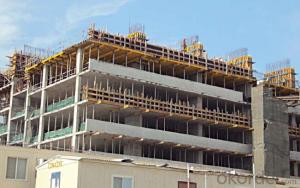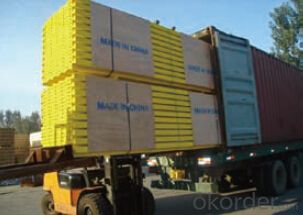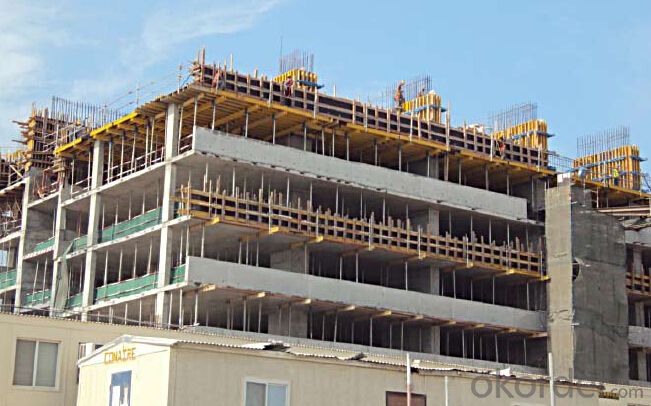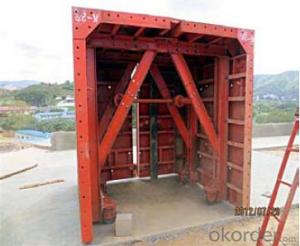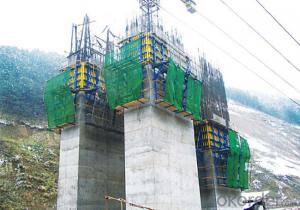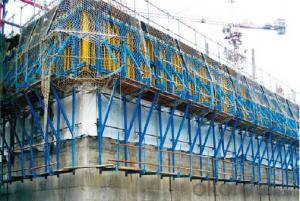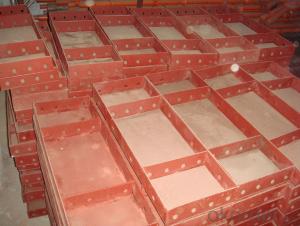Timber-Beam Formwork and H20 for Formwork and scaffolding system
- Loading Port:
- Tianjin
- Payment Terms:
- TT OR LC
- Min Order Qty:
- 50 m²
- Supply Capability:
- 1000 m²/month
OKorder Service Pledge
OKorder Financial Service
You Might Also Like
Characteristics:
◆ Standardized production lines.
Supply capability: 3000m/day, Lmax = 6600mm.
◆ Finger jointing of the flange and web, the strength of timber beam is highly improved.
Max. shearing force failure load:40KN
◆ Well treated to prevent from water penetration or erosion, so the service life maximally
extended.
Normally, CNBM timber beam H20 can be used for 4 to 5 years, the exact using time would
depend on maintenance & storage.
◆ Robust caps at the end of the girders protect against damages.
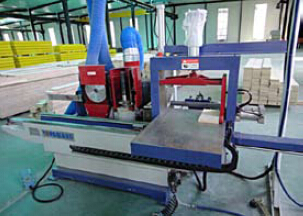
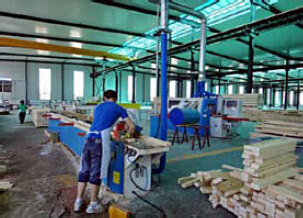
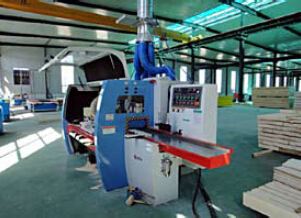
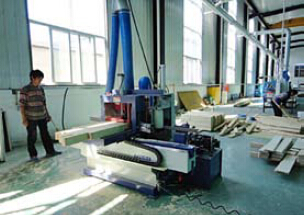
- Q: Can steel formwork be used for projects with stringent quality requirements?
- Yes, steel formwork can be used for projects with stringent quality requirements. Steel formwork offers high strength, durability, and dimensional accuracy, making it suitable for projects that demand precise and consistent results. Its ability to withstand heavy loads and extreme weather conditions ensures the quality and stability of the concrete structure. Additionally, steel formwork can be easily customized and reused, resulting in cost-effective and efficient construction processes for projects with strict quality standards.
- Q: Can steel formwork be used for both small and large-scale construction projects?
- Yes, steel formwork can be used for both small and large-scale construction projects. Steel formwork is highly versatile and can be easily customized to meet the specific requirements of different project sizes. It offers strength, durability, and stability, making it suitable for various construction applications, ranging from small residential buildings to large commercial structures.
- Q: What are the common accessories and attachments used with steel formwork systems?
- There are several common accessories and attachments used with steel formwork systems to enhance their functionality and efficiency. Some of these include: 1. Formwork clamps: These are used to securely hold the steel formwork panels together. They provide stability and prevent any movement or shifting during the concrete pouring process. 2. Formwork ties: These are used to connect the steel formwork panels and ensure they remain in the desired position. Formwork ties help distribute the pressure evenly across the formwork, preventing any bulging or deformation. 3. Formwork props: These adjustable steel props are used to support the weight of the formwork and the freshly poured concrete. They provide additional strength and stability to the structure, ensuring proper alignment and preventing any collapse. 4. Formwork brackets: These brackets are used to attach the formwork to the existing structure or to create additional support. They help in maintaining the desired shape of the formwork and provide stability during the concrete pouring process. 5. Formwork corners: These accessories are used to create sharp corners or angles in the formwork. They ensure that the concrete is poured accurately and that the structure maintains its desired shape. 6. Formwork spacers: These are used to maintain the proper spacing between the formwork panels, ensuring that the concrete is poured evenly and uniformly. They help in achieving a smooth and even finish on the concrete surface. 7. Formwork release agents: These substances are applied to the formwork surface to prevent the concrete from sticking to the steel panels. This allows for easy removal of the formwork once the concrete has cured. 8. Formwork leveling devices: These are used to ensure that the formwork is level and properly aligned. They help in achieving a consistent and uniform concrete finish. Overall, these accessories and attachments play a crucial role in the successful implementation of steel formwork systems. They enhance the structural integrity, improve efficiency, and ensure a high-quality finish for the concrete structures being constructed.
- Q: The wooden plank road construction, the steel structure and the template pavement, the railing installation all construction labor cost to want how many money? Or how much a square?
- Labor costs per ton steel production and installation: material loss making 1000 to 1300 + 3%+, 400 + 600+ installation to transport tax management fees, general standard workshop, steel 3 to 10 yuan per square metre, specifically to see the extent of the version and the difficulty
- Q: How does steel formwork affect the overall construction waste management?
- Steel formwork can significantly impact overall construction waste management by reducing waste generation and improving recycling opportunities. Unlike traditional timber formwork, steel formwork is more durable and can be reused multiple times, reducing the amount of waste generated during the construction process. Additionally, steel formwork can be easily dismantled and transported, allowing for efficient recycling and proper disposal of construction waste. This not only minimizes the environmental impact but also reduces the cost associated with waste disposal, making steel formwork a more sustainable and cost-effective solution for construction waste management.
- Q: How does steel formwork handle different concrete expansion properties?
- Steel formwork is a highly durable and rigid material that can easily handle different concrete expansion properties. Its strength and stiffness allow it to withstand the pressure exerted by expanding concrete without deforming or cracking. Additionally, steel formwork is typically designed with expansion joints or gaps, which provide sufficient space for the concrete to expand and contract without causing any structural issues. This ensures that the formwork remains intact and maintains its shape, allowing for successful concrete pouring and curing.
- Q: How is steel formwork used in construction projects?
- The technique of steel formwork is widely employed in construction, using steel panels and frames to create temporary molds or formworks. These formworks are utilized to shape and provide support for wet concrete until it sets and solidifies into the desired structure. When it comes to construction projects, steel formwork is mainly utilized for large-scale endeavors like high-rise buildings, bridges, and dams. The use of steel formwork offers several advantages over traditional timber formwork, including enhanced strength, durability, and the ability to be reused. To utilize steel formwork, the initial step involves designing and fabricating the steel panels and frames based on the specific project requirements. These panels are typically made from high-quality steel, ensuring they are strong enough to withstand the weight and pressure of wet concrete. Once the steel formwork is fabricated, it is transported to the construction site and assembled by skilled workers. The panels are connected together using various methods such as clamps or bolts, creating a sturdy framework. This framework serves as a mold, providing support and containment for the wet concrete. The steel formwork is then meticulously positioned and aligned according to the project plans. Reinforcement bars, also known as rebars, are often placed within the formwork to add strength to the final structure. Once everything is in place, the concrete is poured into the formwork, filling the designated areas. During the curing process, the steel formwork plays a vital role in ensuring the concrete maintains its shape and strength. The steel panels prevent the concrete from bulging or deforming under its own weight, resulting in a finished product that is of high quality and structurally sound. After the concrete has hardened and gained enough strength, the steel formwork can be removed. Due to its durability and ability to be reused, the steel formwork can be disassembled and utilized in multiple construction projects, making it a practical and sustainable option. In conclusion, steel formwork is a crucial element in construction projects, offering a reliable and efficient method for shaping and supporting wet concrete. Its strength, durability, and reusability make it a popular choice for large-scale projects, ensuring the successful completion of various structures.
- Q: How does steel formwork contribute to the overall cost-effectiveness of the construction process?
- Steel formwork contributes to the overall cost-effectiveness of the construction process in several ways. Firstly, steel formwork is highly durable and can be reused multiple times, reducing the need for frequent replacements and lowering the overall material costs. This durability also leads to reduced maintenance and repair expenses, further enhancing the cost-effectiveness. Secondly, steel formwork offers excellent dimensional stability, ensuring that the concrete structures are built with precision and accuracy. This results in reduced wastage of materials, as the formwork provides a reliable template for the desired shape and size of the concrete elements. Minimizing material wastage directly contributes to cost savings. Moreover, steel formwork provides faster construction cycles due to its ease of assembly and disassembly. The interlocking panels and adjustable features make it quick and efficient to set up, saving valuable time and labor costs. The seamless integration of steel formwork with modern construction techniques, such as mechanized systems, further enhances productivity and reduces construction time. Furthermore, steel formwork offers flexibility and adaptability, allowing for customization and adjustments as per project requirements. It can be easily modified to accommodate changes in design or specifications, reducing the need for additional formwork or costly modifications. This adaptability enhances cost-effectiveness by avoiding unnecessary expenses. Additionally, steel formwork is known for its high strength and load-bearing capacity, enabling it to withstand heavy loads and provide a safe working environment. This strength eliminates the need for additional support structures, reducing the overall material and labor costs. Overall, the use of steel formwork in the construction process contributes to cost-effectiveness through its durability, reduced material wastage, faster construction cycles, flexibility, and strength. By optimizing resources and enhancing efficiency, steel formwork helps to minimize expenses, making it a cost-effective choice in construction projects.
- Q: What is the weight of steel formwork panels?
- The weight of steel formwork panels can vary depending on the size, thickness, and design of the panels. On average, steel formwork panels can range from 20 to 30 kilograms per square meter. However, it is important to note that this weight can increase or decrease based on specific project requirements and customization. Additionally, it is advisable to consult with manufacturers or suppliers to obtain accurate and up-to-date information on the weight of steel formwork panels for a particular application.
- Q: What are the typical sheet thicknesses used in steel formwork panels?
- The typical sheet thicknesses used in steel formwork panels can vary depending on the specific application and requirements. However, commonly used sheet thicknesses range from 6mm to 12mm. Thicker sheets are usually preferred for heavy-duty applications or when higher load-bearing capacities are needed. On the other hand, thinner sheets can be used for lighter applications or when weight reduction is a priority. It is important to consider factors such as the size of the formwork panel, the desired strength and durability, and the anticipated loads when determining the appropriate sheet thickness for steel formwork panels.
Send your message to us
Timber-Beam Formwork and H20 for Formwork and scaffolding system
- Loading Port:
- Tianjin
- Payment Terms:
- TT OR LC
- Min Order Qty:
- 50 m²
- Supply Capability:
- 1000 m²/month
OKorder Service Pledge
OKorder Financial Service
Similar products
Hot products
Hot Searches
Related keywords

